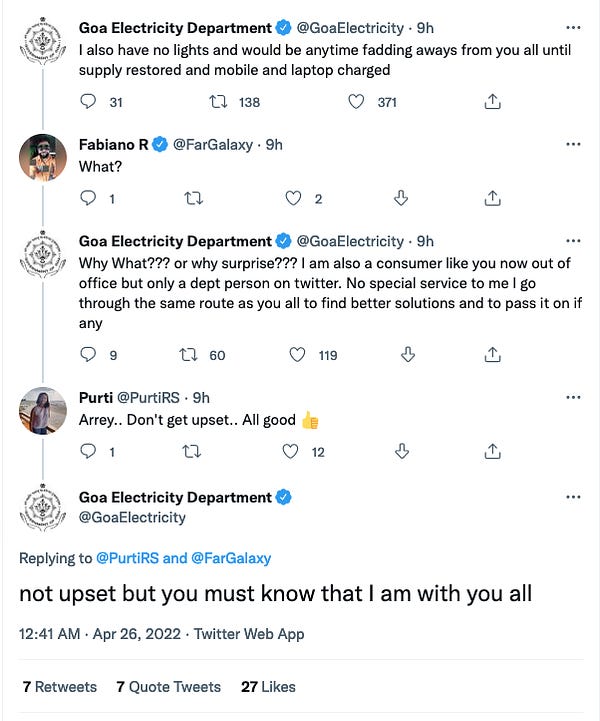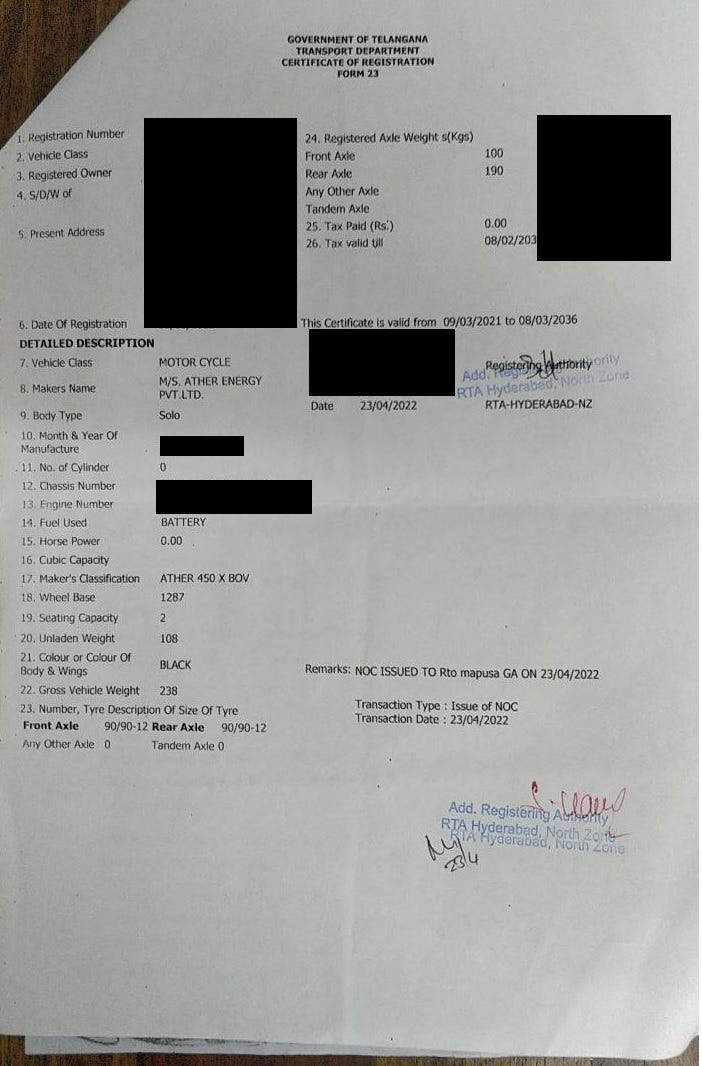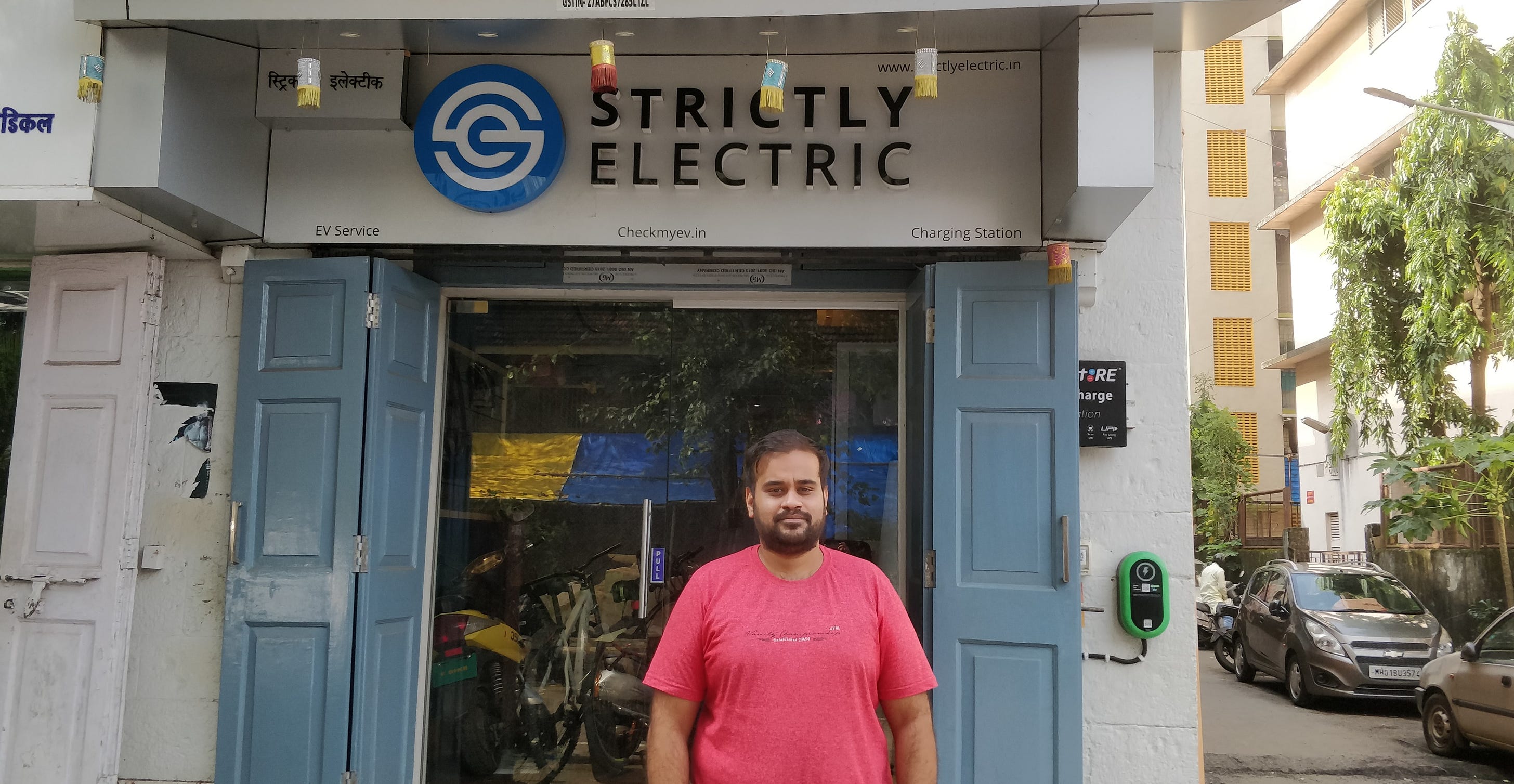How do you fix India's electric dreams, anyway?
How do you fix India's electric dreams, anyway?Adoption of EVs is constrained by the lack of an after-sales service network
Good morning! A big hello to readers who signed up this week. Welcome to The Intersection, The Signal's weekend edition. This weekend we talk about roadblocks for electric vehicles in India. Also in today’s edition: we have curated the best weekend reads for you. If you enjoy reading us, why not give us a follow at @thesignaldotco on Twitter and Instagram. On a long and lonesome highway….The sun had finally set in Davangere, Karnataka, ending a very exhausting day for Priyans Murarka. What was supposed to be a day’s drive from Bengaluru to Mumbai spun out into a long grapple with electronic circuitry and corporate bureaucracy. Murarka had stopped in the afternoon to charge his MG Hector electric car at a Tata Power electric charging station in Davangere, about 280 km from Bengaluru. But a tripped software lock wouldn’t let the car charge up. Electric cars have two batteries—the main one that drives the vehicle and an auxiliary that helps other operations such as opening doors and windows, and powering onboard computers that control the vehicle. The software lock is like a circuit breaker to protect the main battery in the event of voltage or power fluctuations. As the chief technology officer at ActiveBuildings, a startup that makes digital solutions to monitor the indoor air quality of homes, businesses, factories, and even communities, Murarka knows a thing or two about computers and electronics. He connected with a local electric vehicle (EV) community to troubleshoot. He stayed on the phone with MG Motor India’s support team for nearly seven hours, but the lock stayed firmly on. Finally, MG towed the car away to its nearest service station, which was in Bengaluru. What annoyed Murarka—a careful driver, EV enthusiast, and meticulous chronicler of his experiences with EVs—the most was the walled garden. MG technicians could fix the software issues only at an MG garage using proprietary software on company laptops. The Hector EV has a five-year warranty, but it’s unclear what happens once it expires. And what about the average EV user who doesn’t possess any technical knowledge? EV adoption is still nascent in India, but the numbers are picking up. The Indian government counts over 1.3 million electric vehicles on the road as of July 2022. The road transport and heavy industries ministries are pushing for greater EV adoption. Union road transport minister Nitin Gadkari expects more than 30 million EVs on the road in the next two years. The government’s Faster Adoption and Manufacturing of (Hybrid &) Electric Vehicles in India (FAME India) Scheme has been instrumental in creating demand by subsidising manufacturing costs. It also explores several initiatives to expand charging networks and encourage battery swapping. Yet, it is silent on building a viable EV repair ecosystem. MG Motor India declined to answer The Intersection's questions for this story. The Intersection contacted nine EV manufacturers, including Mahindra Electric, Tata Motors, Bajaj Auto, TVS Group, Ather Energy, Sun Mobility and other startups for comment, but none have responded. This story will be updated if and when they do. At the moment, it is a chicken and egg situation. There are not enough vehicles on the road for independent service stations to sustain, but adoption will be slow because of the lack of a service network. Murarka says a majority of EV customers in India don’t have access to after-sales service or repair expertise. Right to repair acquires a certain urgency in the backdrop of the series of EV fires in the summer of 2022. Eight people were killed in Secunderabad on September 13 when a fire broke out in a building that housed an e-scooter showroom. While some companies offer breakdown assistance to customers, a majority of EV owners struggle to access repair services. It’s worse for two-wheeler owners who rely mostly on help from EV enthusiasts and jugaad fixes. PlugInIndia, an advocacy and support group for EVs in India, runs a popular YouTube channel and deals with community members’ issues on its Discord channel. Raphae Halim, a reviewer at PlugInIndia, explains that it shut down a popular tracker on EV issues and breakdowns on YouTube because it could not cope with demand. “We would try our best to help using our personal connections in companies to sort things out, but that’s not a viable option,” says Halim. “It’s a bigger systemic problem. Manufacturers and dealerships are not listening to customers.” We Didn’t Start The FireMonsoon in Goa is a delight and throws up many Instagram-worthy moments. The rains also bring with them frequent power outages. So much so that the state’s electricity situation has reached meme-level notoriety. Rains are also tricky for gadgets as moisture accumulates in delicately soldered circuits. Customers walking in with smoking gadgets is routine for Goan computer and mobile repair shops. Romulo Noronha, who runs the computer repairs shop India Digital in Mapusa, Goa, however, has been getting a new type of customer. Noronha, who specialises in chip-level fixes, says he has been getting requests to fix EV chargers. He told The Intersection that he has fixed about half a dozen chargers in the past eight-nine months, and is already envisioning a profitable foray into EV repairs. “The issues are just basic electronics for me,” he says. A common complaint is blown fuses or burnt circuit boards due to power fluctuations. The circuit boards were similar to those in some laptop chargers and could be used in EV batteries too. Electric vehicles have fewer mechanical moving parts compared to ICE vehicles, but they do require serious electrical, electronics, mechanical, and software engineering chops to repair. So, it is difficult for ICE mechanics to branch into EVs. “The main parts of an EV that often need repair are the electric motor, electronic controller, battery, and charger,” explains Vikas Kamble, who runs Sharanya Motors, an exclusive e-bike garage in Pune. “There are also wiring issues, brake cables, display problems, suspension, and handling systems on the hardware side of things,” he adds. Kamble, who has been tinkering with electric scooters since 2010, says that he sees about 15-20 customers a day. Durgesh Garud, the co-founder and CEO of Strictly Electric and CheckMyEv, a Mumbai-based garage for electric scooters and modifying bicycles to electric, says companies are uninterested in standardisation. They prefer to develop proprietary technology to ensure customers are tethered to them. Kamble showed The Intersection a bunch of chargers from different e-scooters. Each had different wattage requirements, circuit boards, pin connectors and other components. Kamble has been sourcing parts from electronics dealers in Delhi and China, and has to give precise instructions to his vendors on design specifications. With frequent usage, electric motors pick up a lot of gunk and grime, which interferes with a detector crucial to EVs called a Hall Effect sensor. It measures current and electrical flux by detecting changes in magnetic fields. “Each company uses its own Hall sensor designed for the specifications of the electric motor,” says Sidney Gideon, who runs Electric Wheels, a multi-brand electric scooter dealership and repair shop in Mapusa. “We have to source them directly from the manufacturer.” Battery Is Here To StayRepairing electric motors isn’t a big deal, as the know-how to mend them is fairly common. Batteries, however, are a whole different ball game. Their chemistry is complex and can be volatile in certain conditions such as Indian summers. Most electric vehicles run on lithium-based batteries, but the low-speed e-rickshaws ubiquitous in the Delhi-National Capital Region (NCR) operate on lead-acid cells. The e-rickshaw is a poorly-designed product of India’s jugaad culture. They have limited range, speed and safety. The commonly used lithium-based batteries have different chemistries, yielding between 650 and 2,000 charge/discharge cycles. They also promote varying thermal runoffs (one of the main causes of fires) and have different costs and performance. Individual cells in a battery pack may degrade more than others, so it becomes important for users to periodically rebalance cells at an authorised service centre or a competent mechanic. While it is important for users to have basic knowledge of the batteries in their vehicles, more detailed data is necessary for regulators. The current vehicle registration process is geared towards ICE vehicles. Registration certificates (RC) for EVs merely mention fuel used as ‘battery’. Ironically, the RCs for EVs have fields for cubic capacity and horsepower, specifications that only make sense for ICE vehicles. To build an interoperable battery swapping ecosystem, it is important for regulators to gather granular information, including the chemistries of batteries and degradation states. OK, Computer?It’s helpful to think of electric vehicles as digital devices. Just as we have CPUs in computers, EV operations are controlled by chipsets. Electronic controllers in EVs can be replaced. But that depends on the manufacturer, as replacing electronic controllers is like replacing the engine of an ICE vehicle. Just as the Regional Transport Offices (RTOs) note the engine number of an ICE vehicle, registering bodies should be collecting data about the electronic control units in EVs, says PlugInIndia’s Halim. “Ideally, the government should be getting details of traction controller units in production. All of them have a serial number, and that should be getting captured along with the firmware version during registration,” adds Halim. Firmware refers to a piece of software that is embedded into hardware that provides low-level control. With periodic updates, EVs resemble smartphones and laptops, with yearly updates to the operating systems and firmware. There is consensus among the EV community, garages, and repair shops that keeping track of firmware and battery management software (BMS) would be key to the evolution of India’s EV industry. Repair shop owners say that BMS doesn’t exist in most e-scooters. A NITI Aayog status report on EVs in India stressed the need to have a BMS to prevent EV fires as part of proposed standard operating procedures. Most products in the e-scooter market are in the low-speed category (vehicles with a top speed of 25 kph and do not require any registration or licence), and manufacturers don’t particularly invest or have an incentive to develop a BMS for these vehicles. There is also significant regulatory grey space when it comes to retrofitting ICE vehicles with electric kits. Sharanya Motors’ Kamble said that he did modify some Honda Activa scooters with an electric conversion kit, but he is unsure if it is allowed. CheckMyEv’s Garud says that his garage started by fitting bicycles with electric kits and that since this modification was of a low-speed vehicle, there wasn’t a need to register the upgrades with the Automotive Research Association of India (ARAI), the industrial research association of the Indian automotive industry. Nonetheless, there are companies such as Hyderabad-based eTrio and Pune-based Northway Motorsport that retrofit ICE cars with electric kits and claim to have certifications from ARAI. But it is unclear if ARAI has mandated these companies to install a BMS. For PlugInIndia’s Halim, getting software right on EVs is non-negotiable, as glitches could mean life or death for the driver. To him, incidents like Ola’s e-scooters shifting to reverse mode at full speed are inexcusable, and the tech and software industry’s lax practices with the “ship now, fix later” culture cannot work in the EV industry. Halim, who has a post-graduate diploma from the Centre for Development of Advanced Computing and also consults with technology companies on software development, believes that BMS cannot be built in silos by manufacturers, adding that they need to be made open source to iron out bugs in code. The Indian government’s public policy think tank NITI Aayog and the Department of Science and Technology are reportedly developing an open source BMS, and electric scooter manufacturer Okinawa is testing the software. Not everyone favours stiff technical standards and specifications. Sanjeev Ahluwalia, a former bureaucrat and now senior advisor at policy think-tank Observer Research Foundation says tough specs could end up favouring entrenched companies and stifling innovation. Instead, the government should use existing policy tools more judiciously. For instance, the FAME subsidy could be tweaked to incentivise companies that help create a repair ecosystem, open service shops, train technicians, and create a robust supply chain for parts, Ahluwalia says. Halim believes there should be a lot more tinkerers to push the next phase of automotive technology. Manufacturers should not penalise customers for trying to fix the software and hardware in their vehicles like US tractor maker John Deere and Tesla do. His next project is to install an active cell balancer on his Mahindra e2O to extend the life of batteries, and hopes that this feature will become a default in all EVs. He’s got an ally in NITI Aayog, and its report on SOPs recommends active cell balancers on EVs. Meanwhile, Murarka is still waiting for answers. “Right now, I want to know why the software lock was triggered, and I haven’t gotten a proper response from the company,” he says. “It’s important to me because I don’t want to let my family use this vehicle and be stranded. Their explanation will give me information on what to avoid next time and take precautions.” ICYMIPerfect toy: Kids get older, trends come and go. But few toys stand the test of time, and get passed from one generation to the next. Lego, Barbie, Play-Doh and Rubik’s Cube are classic examples. What do these have in common? Well they’re mostly nostalgic, low tech, and involve some sort of problem-solving or imaginative thinking. So, what’s the recipe for the perfect toy? This piece details it all. Goodbye, GOAT: Tennis will never be the same without Roger Federer. As the 41-year-old Swiss legend plays in his final tournament before hanging up his racquet, read this lovely tribute by Christopher Clarey in the New York Times. It’s about why every tournament felt like a home tournament for Federer no matter which part of the globe he was playing in. Clarey tries to comprehend what lay behind that deep connection Federer had with so many different cultures. It’s what truly made him the GOAT, no matter what the statistics say. Showtime? Hollywood's got a China problem that needs more than just fairy dust to revive its business. Even as theatrical releases are flowing to China, they aren’t reaping as much money. One reason? Political tension between US and China and surging nationalism mean a preference for local films. Chinese movies are striking it big, in comparison. It doesn't help that most American releases are centred on American nationalism, further alienating the international audience. This story details what's ailing Hollywood in China. Tune in: In 2000, Adnan Syed a 17-year-old high school student from Baltimore was convicted of murdering his girlfriend, Hae Min Lee. But few could have foretold that this case would lead to the creation of what would be the most popular true-crime podcast ever. Over a span of 12 episodes, Serial: Season 1 hosted by Sarah Koenig, probed into the details of this case, raising doubts around Adnan's conviction. Eight years after its release, a 13th episode was added to the first season, as Adnan, now a 41-year-old man, walked out of jail after a Baltimore judge overturned his conviction. Whether or not, Serial had an influence on the case, it definitely changed the game for the true crime genre. This weekend check out the latest episode of Serial or better, binge on the series. Triumph in China: While TikTok is squirming under scrutiny in the US and Europe, it is turning up to be a big hit in China with its sister app, Douyin. It is aggressively pushing its live-streaming e-commerce business focused on not just celebrity sellers, but smaller brands as well. However, only 1%–5% of sales value comes from commission. So most of Douyin’s profits are generated by strong advertising revenue. Also, since users can complete all transactions in the app itself, they stay on longer. Il Duce’s legatees: Angry Italian households faced with rising food and energy bills will likely install the country’s first far right prime minister since Benito Mussolini in the last century. Giorgia Meloni, leader of the Brothers of Italy and a member of a neo-fascist political setup in her youth, and her ally, Matteo Salvini of the League are seen forging a coalition government that will pull Italy farther away from the European Union. The election will further complicate European politics that has been torn asunder by the Russia-Ukraine war. While Meloni says she is committed to fiscal prudence, Salvini is openly populist. This Financial Times story sketches out the pulls and pressures shaping Italian politics. Enjoy The Intersection? Consider forwarding it to a friend, colleague, classmate or whoever you think might be interested. They can sign up here. Want to advertise with us? We’d love to hear from you. Write to us here for feedback on The Intersection If you liked this post from The Signal, why not share it? |
Older messages
Double-Job trouble
Friday, September 23, 2022
Also in today's edition: Biscuit brand power; Crypto, PEs take the rap; US banks to follow government order on China; Reliance Retail presses on
Google’s choice
Thursday, September 22, 2022
Also in today's edition: Spotify's Audible ambitions; Facebook tries democracy; Luxury beats inflation; It's YouTube vs TikTok
Adani lays concrete plans
Wednesday, September 21, 2022
Also in today's edition: Apple's puppet; Bangalore baker trounces Amazon; Will NPCI cap it or cop out? Plant-based meats are uncool now
Aadhaar gets a security patch
Tuesday, September 20, 2022
Also in today's edition: VCs, PEs under Sebi's scanner; Apple TV's dilemma; The youth are done working; Jet 2.0 is waiting for engines
Nightmare for investors
Monday, September 19, 2022
Also in today's edition: China has caught the chill; Russian rock, Indian cut; I-bankers go corporate; SCO concludes
You Might Also Like
How This "1 PAGE" Website Makes $21,000/Month!
Wednesday, January 15, 2025
I just uncovered a website that is just a single page, and get this...it's making over $21000/month! In my video today, I'm going to reveal this website, how its getting traffic, and how its
$1,654 in DAILY sales 😮 (Beta-Tester results + NEW system)
Wednesday, January 15, 2025
This needs to be seen to be believed View in browser ClickBank Hey there, This coming Sunday, I highly recommend attending this private event because you'll be shown something brand new. Here's
Founder Weekly - Issue 669
Wednesday, January 15, 2025
January 15, 2025 | Read Online Founder Weekly (Issue 669 January 15 2025) In partnership with Where tier-one VCs get their news 📰 Get smarter about venture capital. 5x / week <5 minutes / day 15000
Building AI Agents the Easy way
Wednesday, January 15, 2025
Today's Guide to the Marketing Jungle from Social Media Examiner... Presented by social-media-marketing-world-logo It's National Bagel Day, Reader! Do you like yours sweet, savory, or plain? In
Are you a Chaos Coordinator? It's one of the top gifts on Amazon
Wednesday, January 15, 2025
Trending Products on Amazon This Week For the week of Monday, January 13 to Sunday, January 19 Welcome to this week's edition of the hottest trending keywords and products on Amazon over the last
The Market Is Pushing Asset Prices After Inflation Report — But Should It Be?
Wednesday, January 15, 2025
Listen now (2 mins) | To investors, ͏ ͏ ͏ ͏ ͏ ͏ ͏ ͏ ͏ ͏ ͏ ͏ ͏ ͏ ͏ ͏ ͏ ͏ ͏ ͏ ͏ ͏ ͏ ͏ ͏ ͏ ͏ ͏ ͏ ͏ ͏ ͏ ͏ ͏ ͏ ͏ ͏ ͏ ͏ ͏ ͏ ͏ ͏ ͏ ͏ ͏ ͏ ͏ ͏ ͏ ͏ ͏ ͏ ͏ ͏ ͏ ͏ ͏ ͏ ͏ ͏ ͏ ͏ ͏ ͏ ͏ ͏ ͏ ͏ ͏ ͏ ͏ ͏ ͏ ͏ ͏ ͏ ͏ ͏ ͏ ͏ ͏ ͏
When Video Matters And When It Shouldn't
Wednesday, January 15, 2025
Humans, it seems, like to be all or nothing on things. It's a Twitter-killer or a Google-killer. Not here's another way to access content or do things. It's all or nothing. And that's
😎Wake up, babe. State of Marketing just dropped.
Wednesday, January 15, 2025
Data and insights from 1.4k marketers globally View in browser hey-Jul-17-2024-03-58-50-7396-PM The webcomic XKCD once estimated that, on average, there are 10000 people hearing about something “
VC climate-tech funding falls for 3rd year
Wednesday, January 15, 2025
PE's comeback hits a speed bump; meet Europe's new crypto unicorn; Macquarie inks $5B data center partnership Read online | Don't want to receive these emails? Manage your subscription. Log
🦅 We're rescheduling Jesse Pujji's masterclass
Wednesday, January 15, 2025
It will be in March ͏ ͏ ͏ ͏ ͏ ͏ ͏ ͏ ͏ ͏ ͏ ͏ ͏ ͏ ͏ ͏ ͏ ͏ ͏ ͏ ͏ ͏ ͏ ͏ ͏ ͏ ͏ ͏ ͏ ͏ ͏ ͏ ͏ ͏ ͏ ͏ ͏ ͏ ͏ ͏ ͏ ͏ ͏ ͏ ͏ ͏ ͏ ͏ ͏ ͏ ͏ ͏ ͏ ͏ ͏ ͏ ͏ ͏ ͏ ͏ ͏ ͏ ͏ ͏ ͏ ͏ ͏ ͏ ͏ ͏ ͏ ͏ ͏ ͏ ͏ ͏ ͏ ͏ ͏ ͏ ͏ ͏ ͏ ͏ ͏ ͏ ͏ ͏ ͏ ͏ ͏







